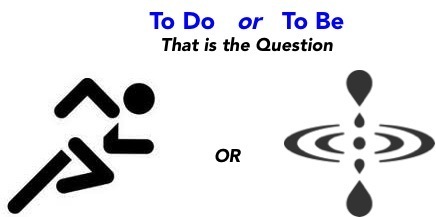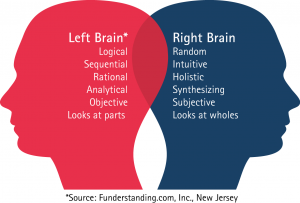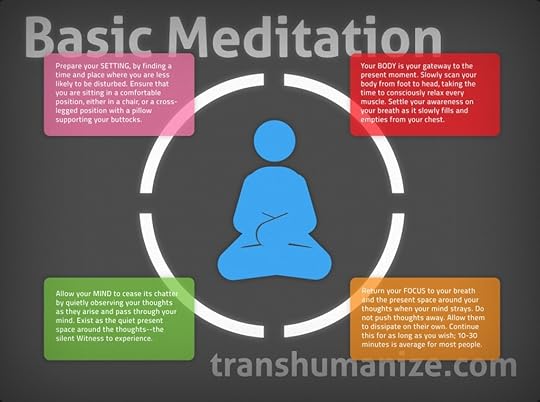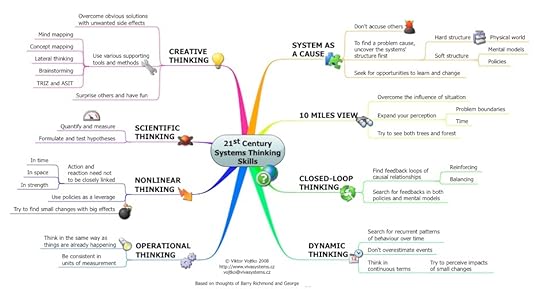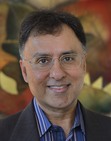To Do, or To Be?
To Do, or To Be - That is the Question. We’ve been conditioned over the last fifty years to believe that we can logically think through any issue and achieve any desired accomplishment, simply by trying harder and taking stronger action. On the other side, the new age movement has been centered on going inward and using meditation and visualization to manifest success through our thoughts. But the greatest minds over the ages have always known that it is the combination of the workings of the left and right brain that provides the greatest results.
To access the unlimitless inspiration that the right-brain can provide, there is no better tool than meditation. The list of business people, entrepreneurs, scientists, and artists who practice meditation and mindfulness to amplify their professional results is growing daily. Here is a small sample from the past and present:
Business
Larry Ellison – CEO, Oracle
Bill George – CEO retired, Medtronic
Ray Dalio – CEO, Bridgewater Associates
Rupert Murdoch – CEO, Newscorp
Oprah Winfrey, CEO, O Network
Padmasree Warrior, CTO, Cisco Systems
Bill Ford, Chairman, Ford Motor
Arianna Huffington, CEO, Huffington Post
Steve Jobs, CEO, Apple
Science and Medicine
Albert Einstein, Quantum Physicist
Peter Russell, Quantum Physicist
Amit Goswami, Quantum Physicist
Isaac Newton, Physicist
Benjamin Franklin, Inventor
Dr. Mehmet Oz, Cardiac Surgeon
Writers
Jack Canfiield
Wayne Dyer
Henry David Thoreau
Ralph Waldo Emmerson
Artists / Actors / Musicians
Mozart
Russell Brand
Jim Carey
Sheryl Crow
Hugh Jackman
Ellen Degeneres
Paul McCartney
David Lynch
Martin Scorsese
Herbie Hancock
Clint Eastwood
Jerry Seinfeld
Sting
Albert Einstein meditated a few times a day. As he famously said,
It was the way to get answers even before you asked the questions.
Matthew E. May wrote in Strategy + Business magazine in February 2013 that “Meditation – a practice that eliminates distraction and clears the mind – is an effective way to enhance self-awareness, focus, and attention, and to prime your brain for achieving creative insights. Oracle chief executive Larry Ellison meditates (up to three times per day), and asks (it’s an actual job requirement) his executives to do the same. In 2007, Google initiated a mindfulness and meditation course at its Google University to help its employees maintain the company’s strong track record for innovation. Leaders at GE, 3M, Bloomberg Media, Green Mountain Coffee Roasters, and Salesforce.com meditate.”
So that’s the ‘Be” part. Calm and focus the mind and as a result achieve greater clarity, insight, creativity, and personal awareness. Oh, and dramatically reduce your stress and improve your health. A very high Return on Investment for 20 minutes a day.
But we can’t just “Be”. The names on the list above are all very successful in their respective fields, they are accomplished doers. So, the “Do” is just as important and it is when we use the “Be” to tap into our right-brain creativity and intuition to feed into our “Do” efforts on a daily basis, that we create a powerful catalyst for personal transformation and accomplishment.
So is there a special something that highly accomplished doers do better than others? Large amounts of practice (the famous 10,000 hours), a certain level of innate talent, and an un-bending will to succeed are all part of the mix. But there is also one other ingredient that in today’s interconnected, global, and high-tech world is in many ways the key determinant to success – They Continuously Learn.
In today’s world, those who want to succeed, know they must embrace change, growth, and assimilate knowledge faster than ever before. The world’s knowledge, which is growing exponentially, is on-line and available to more and more people around the globe. Competitive advantage through access to restricted amounts of knowledge and information is becoming harder to achieve. The 13 year old in Kuala Lampur is taking the same graduate level MIT electrical circuits class on line as the engineering professional trying to get his Masters degree part time. Competitive advantage today is through who can more proactively, rapidly, and effectively take advantage of the world’s collective knowledge which is readily available online and available to everyone.
Proactive Learning is something that both children and adults should learn and practice. It’s an aspect of critical thinking that forces us to move from a reactive or passive approach to ingesting our 24/7 stream of media and entertainment to a proactive thinking one. What are some of the key components to this?
Formulate Great Questions – the act of generating a question, immediately takes you out of the reactive mode and into the proactive stance. “If you do not ask the right questions, you do not get the right answers. A question asked in the right way, often points to its own answers. Asking questions is the A-B-C of diagnosis. Only the inquiring mind solves problems.” – Edward Hodnett. It is the art of the question that sets you up for getting to the heart of any subject.
Master the art of Internet Search – once you start generating great questions, you need an effective way to locate the best answers. Most people are unaware of all the different methods to find the best answers on Google or other search engines. Typing in a simple query in the search bar and browsing through the first 20 hits out of 90,000,000 will get you some level of information (the most popular), but perhaps not the best and most helpful for your particular needs. Professional researchers in many fields are very sophisticated in their approach – with proper technique in their queries, they can reduce that 90,000,000 result down to 300 of the most relevant sources to their inquiry within minutes. If Google is the world’s collective human knowledge on line – developing the skills to access the best information is an extreme competitive advantage.
Ingest only High Quality Information, Media, and Entertainment. We have a limited amount of time every day, but an endless supply of media and information to consume. Just as with food, we are what we consume. These are some of the questions I use to determine what sources of media and information to consume. I’m sure there are others:
Does it educate in a meaningful way?
Does it uplift?
Does it provide non-obvious insight?
Is it truthful?
Does it seek to bring people together?
Is the source based on a quest to help people understand themselves and others better?
Does the source seek to improve the state of humanity and the world or does it play to the most crass aspects of our human nature?
Of course, sometimes, a piece of fluff is just what the doctor ordered. The brain needs that from time to time. But eat fluff on a daily basis, and well, you know what happens. There is a saying in sports – “You need to play up”. Which means in order to improve your game, you need to play with people better than you. The same goes for learning. If you want to expand your mind you need to challenge yourself with information and ideas beyond your current comfort zone.
4. Learn Systems Thinking. Once we know what we want to find out, know how to get it, ingest only the best sources, then we can move to the next step – putting all the pieces of information that we have available to us and understanding the big picture. Success in the 21st century comes from understanding things at a System Level – how things are interconnected, the feedback mechanisms involved, and how changes in inputs result in different outputs. Essentially processing and making intelligent sense of the massive amount of information engulfing us around the clock. There are a whole array of Systems Thinking tools that professionals in Science, Engineering, Business and other professions use on a daily basis to make sense of our highly complex and interconnected world. They are essentially aids to help us think through issues and see below the surface. What looks like one thing, turns out to be something different when we gain new information or look from a different perspective.
Systems Thinking expert, Linda Booth Sweeney has written of the many benefits of Systems Thinking – here are some:
See the world around us in terms of wholes, rather than as single events, or “snapshots” of life.
See and sense how the parts of systems work together, rather than just see the parts as a collection of unrelated pieces.
See how the relationships between the elements in a system influence the patterns of behavior and events to which we react.
Understand that life is always moving and changing, rather than static.
Understand how one event can influence another, even if the second event occurs a long time after the first, and “far away” from the first.
Know that what see happening around us depends on where we are in the system.
There are many different Systems Thinking tools and techniques to use. One of the easiest to get started with is Mind Mapping. See my previous post – Breakdown of the Shutdown -to see MindMapping in action. You can also get a complete overview of Systems Thinking with a broad array of tools and techniques in chapter five of my book Think Smarter in a Digitally Enabled World. Now available on Amazon and iBooks.
So we started with the a question – To Do or To Be. Hopefully you now agree, that when we combine “Being” with “Doing” we start working and living holistically and tapping into the enormous power of our whole brain. When that happens there is no limit to what we can achieve. To Do and To Be, that is the answer.
The post To Do, or To Be? appeared first on Think Smarter World.

